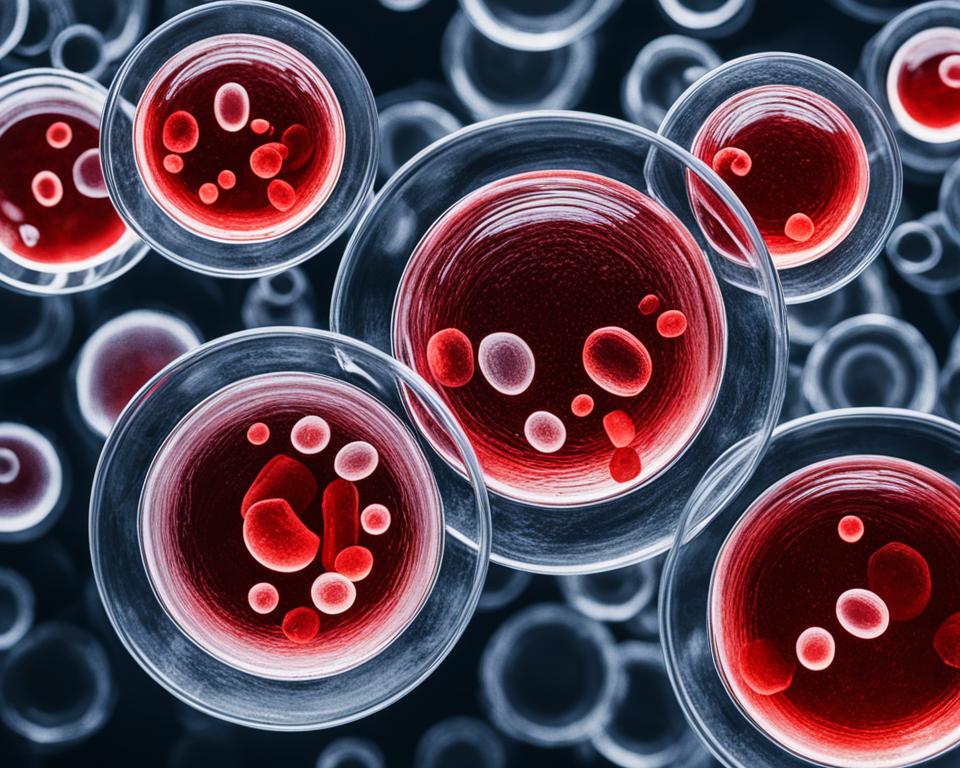
Alcohol and anemia, a blood disorder, are closely related. This article looks at how too much alcohol affects the body’s ability to make healthy red blood cells. It talks about how alcohol can stop iron absorption and affect the production of hemoglobin. This can lead to different types of anemia, each with its own symptoms and problems.
Readers will learn about the link between alcohol and anemia. They will see how alcohol can harm liver function, cause nutritional shortages, and increase the risk of blood disorders. The article will cover tests and treatments for alcohol-related anemia. It aims to help people manage and prevent alcohol’s harm to their blood health.
Read interesting things at : luoghievisioni
Key Takeaways
- Alcohol can make it hard for the body to produce and keep healthy red blood cells, leading to anemia.
- Drinking too much can hurt iron absorption, which is important for making hemoglobin, the protein that carries oxygen in red blood cells.
- Alcohol can make anemia worse by causing nutritional shortages, liver disease, and other problems linked to alcoholism.
- It’s important to find and treat alcohol-related anemia to keep blood health good and avoid long-term issues.
- Eating well and drinking less alcohol can help prevent anemia and support the body’s natural production of red blood cells.
Introduction to Alcohol and Anemia
The link between alcohol and anemia is a big concern for doctors. Anemia is a blood disorder that means there are fewer red blood cells or they don’t work right. It can really affect someone’s health and happiness. It’s important to know how alcohol and anemia are connected to help people stay healthy.
Alcohol is a drink many people enjoy, but it can harm the body’s ability to make healthy red blood cells. The harm from alcoholism effects can cause blood disorders, like anemia. This part will explain how alcohol can lead to anemia and other blood problems.
“Alcohol can have a profound impact on the body’s ability to produce and maintain healthy red blood cells, leading to the development of various types of anemia.”
This section will look into how alcohol and anemia are connected. It wants to give readers the knowledge to understand how alcohol affects blood health. This can help with making better health choices, catching problems early, and helping those affected by these health issues.
What is Anemia?
Anemia is a blood disorder that means there are fewer red blood cells or they don’t work right. These cells carry oxygen to all parts of the body. Knowing about the types of anemia and their symptoms helps in treating it.
Types of Anemia
There are many types of anemia, each with its own cause and signs:
- Iron Deficiency Anemia: This is the most common type. It happens when the body lacks iron, which is key for making hemoglobin. Hemoglobin carries oxygen in red blood cells.
- Vitamin Deficiency Anemia: Not having enough vitamins like folate, vitamin B12, and vitamin C can cause anemia. These vitamins help make red blood cells.
- Hemolytic Anemia: This type happens when red blood cells break down too soon. It can be due to certain blood disorders or genetic issues.
Symptoms of Anemia
People with anemia might feel:
- Fatigue and weakness
- Pale skin, lips, and nails
- Shortness of breath
- Dizziness or lightheadedness
- Rapid or irregular heartbeat
- Headaches
The severity of these symptoms can vary. It’s important to see a doctor for a diagnosis and treatment plan for this blood disorder.
Effects of Alcohol on Red Blood Cell Production
Drinking too much alcohol can harm the body’s ability to make red blood cells. These cells carry oxygen around the body. When you drink a lot, it can slow down how well your body makes these cells.
Alcohol affects red blood cell production in many ways. It can make it hard for the body to get the nutrients it needs, like iron, vitamin B12, and folate. These nutrients are key for making and growing red blood cells. Also, alcohol can hurt the bone marrow, where these cells are made, making it harder to get them into the blood.
| Alcohol Effects | Impact on Red Blood Cell Production |
|---|---|
| Nutrient Depletion | Drinking alcohol can cause a lack of important nutrients like iron, vitamin B12, and folate. These nutrients are vital for making and growing red blood cells. |
| Bone Marrow Damage | Drinking too much alcohol can harm the bone marrow. This is where red blood cells are made. It makes it harder for the body to create these cells. |
| Impaired Absorption | Alcohol can stop the body from absorbing and using the nutrients needed for making red blood cells. This makes the problem worse. |
Alcohol’s effects on making red blood cells can cause blood disorders. One of these disorders is anemia, which means not enough red blood cells or not enough hemoglobin. This can make you feel tired, weak, and not able to carry oxygen well.
It’s important to know how alcohol affects red blood cell production for good health. By understanding the risks, you can take steps to avoid these problems. This helps keep your blood healthy and balanced.
Alcohol and Iron Deficiency Anemia
Alcohol can greatly affect how well the body absorbs and uses iron. Iron is key for making hemoglobin, which carries oxygen in red blood cells. Knowing how alcohol and iron deficiency anemia are linked is important.
How Alcohol Affects Iron Absorption
Alcohol can make it harder for the body to absorb iron. It can mess with the gut’s normal work, making it harder to get essential nutrients like iron. Also, it can slow down enzymes that turn iron into a form the body can use.
Drinking too much alcohol can also lead to not getting enough nutrients. It often takes the place of foods that are full of nutrients. This can mean not getting enough vitamins and minerals that help use iron well, making iron deficiency anemia more likely.
| Impact of Alcohol on Iron Absorption | Mechanism |
|---|---|
| Disruption of the gastrointestinal tract | Alcohol can impair the normal functioning of the digestive system, reducing the absorption of essential nutrients, including iron. |
| Impaired enzyme activity | Alcohol can inhibit the activity of enzymes responsible for converting iron into a form that can be readily absorbed by the body. |
| Nutritional deficiencies | Excessive alcohol consumption can lead to a lack of other vitamins and minerals that support the body’s ability to utilize iron effectively, contributing to the development of iron deficiency anemia. |
Understanding how alcohol effects and iron absorption can help people lower their risk of iron deficiency anemia. This can improve their health and well-being.
The Link Between Alcohol and Anemia
Alcohol and anemia have a complex relationship. Drinking alcohol can affect how the body makes and keeps healthy red blood cells. This can lead to different types of anemia.
Alcohol can make it hard for the body to absorb iron. Iron is key for making hemoglobin, which carries oxygen in red blood cells. This can cause iron deficiency anemia, the most common type.
Drinking too much alcohol can also lead to not getting enough vitamins and minerals. Things like vitamin B12, folate, and copper are important for making healthy red blood cells. Not getting these can cause anemia, like megaloblastic anemia and sideroblastic anemia.
Alcohol also affects the liver, which is important for iron levels. If the liver gets damaged from drinking too much, it can lead to anemia.
| Anemia Type | Mechanism | Impact on Hemoglobin Levels |
|---|---|---|
| Iron Deficiency Anemia | Impaired iron absorption due to alcohol | Decreased hemoglobin levels |
| Megaloblastic Anemia | Vitamin B12 and folate deficiencies from alcohol | Decreased hemoglobin levels |
| Sideroblastic Anemia | Copper deficiency from alcohol | Decreased hemoglobin levels |
In summary, alcohol and anemia are linked in many ways. These include issues with iron absorption, not getting enough nutrients, and liver damage. Knowing about this link helps in preventing and treating alcohol-related anemia and managing blood disorders.
Alcohol and Anemia
Alcohol and anemia have a complex relationship. Alcohol can cause different types of anemia. It’s important to know how alcohol affects the body to understand health risks.
Alcohol can harm red blood cell production. Drinking too much can make it hard for the body to make enough healthy red blood cells. This leads to fewer red blood cells and less oxygen in the body.
Alcohol also affects how the body uses important nutrients like iron, folate, and vitamin B12. These nutrients help make red blood cells. Without them, anemia can get worse, causing specific types like iron deficiency anemia.
Alcohol’s impact on the liver is linked to anemia too. Drinking too much can hurt the liver. This makes it hard for the liver to make proteins and enzymes needed for red blood cells and iron.
| Alcohol and Anemia Relationship | Impact |
|---|---|
| Disruption of red blood cell production | Reduced oxygen-carrying capacity and anemia |
| Impaired nutrient absorption (iron, folate, vitamin B12) | Specific types of anemia (e.g., iron deficiency, megaloblastic) |
| Liver damage from chronic alcohol abuse | Impaired regulation of red blood cell production and iron metabolism |
It’s important for doctors and people with alcohol problems to understand how alcohol and anemia are linked. Knowing how alcohol causes anemia helps in finding ways to prevent it.
Alcoholism and Nutritional Deficiencies
Alcoholism can deeply affect a person’s nutrition, leading to vitamin and mineral shortages. These shortages can cause anemia. Long-term alcohol use makes it hard for the body to get and use important nutrients. This puts alcoholics at risk of not getting enough nutrients.
Vitamin and Mineral Deficiencies in Alcoholics
Alcoholics often lack these vitamins and minerals:
- Iron: Drinking too much alcohol can make it hard for the body to use iron. This can lead to iron deficiency anemia.
- Folate: Alcohol can stop the body from using folate well. Folate is a B-vitamin needed for making red blood cells.
- Vitamin B12: Drinking alcohol can make it hard to get and use vitamin B12. This vitamin is key for making healthy red blood cells.
| Nutrient | Effect on Alcoholics | Potential Consequences |
|---|---|---|
| Iron | Decreased absorption and utilization | Iron deficiency anemia |
| Folate | Impaired metabolism and utilization | Megaloblastic anemia |
| Vitamin B12 | Inhibited absorption and utilization | Pernicious anemia |
These shortages can lead to different kinds of anemia. Anemia means not enough red blood cells or low hemoglobin levels. Fixing these shortages is key to handling alcoholism-related nutritional deficiencies. It also helps prevent anemia.
Alcohol and Liver Disease: Impact on Anemia
Alcohol and liver disease have a complex relationship. Drinking too much alcohol can harm the liver and lead to anemia. This is a serious health issue.
The liver is key in making red blood cells and processing iron. These are vital for healthy hemoglobin levels. But, chronic drinking can damage the liver. This makes it hard for the liver to do its job, leading to anemia.
| Condition | Impact on Anemia |
|---|---|
| Alcoholic Liver Disease | Impaired liver function can disrupt red blood cell production and iron metabolism, leading to anemia. |
| Cirrhosis | Advanced liver scarring can further compromise the liver’s ability to support healthy red blood cell levels, exacerbating anemia. |
| Hepatitis | Inflammation and damage to the liver from viral hepatitis can contribute to the development of anemia. |
Alcohol-related liver disease affects anemia in many ways. It can mess up the production and growth of red blood cells. This means fewer healthy red blood cells. Also, it can make it hard for the body to use iron, which is needed for making hemoglobin.
It’s important to understand how alcohol, liver disease, and anemia are linked. For those dealing with these issues, getting help for liver problems is key. This can help improve red blood cell health and hemoglobin levels.
Identifying Alcohol-Related Anemia
It’s important for doctors to link alcohol use with anemia. Anemia from alcohol can show up in different ways. Doctors must correctly figure out the cause to treat it right. They use tests to spot alcohol-related anemia.
Diagnostic Tests for Anemia
Doctors start by doing a blood test to check for anemia. This test, called a complete blood count (CBC), looks at red blood cells, their size, and the amount of hemoglobin. Tests like a ferritin or iron panel can tell if it’s iron deficiency or another reason.
Doctors might also do imaging tests like a bone marrow biopsy or endoscopic procedures. These help find the main cause of blood disorders. They show how alcohol-related anemia affects health and find other health issues.

Using many tests helps doctors understand alcohol-related anemia well. They can then make a treatment plan that meets the patient’s needs.
Treating Alcohol-Induced Anemia
People with anemia from drinking too much alcohol need special treatment. This treatment aims to fix the causes and bring back healthy red blood cells and hemoglobin levels. It often includes changing diets, taking supplements, and sometimes, medication.
First, it’s key to cut down or stop drinking alcohol. This helps the body heal and make more red blood cells. Eating more iron-rich foods is also vital to fix nutritional shortages that cause anemia.
Dietary Strategies for Treating Alcohol-Induced Anemia
- Incorporate iron-rich foods, such as red meat, poultry, spinach, and lentils, into the diet.
- Increase the consumption of foods rich in vitamin C, as it enhances the body’s absorption of iron.
- Ensure adequate intake of folic acid and vitamin B12, as deficiencies in these nutrients can also lead to anemia.
If diet changes aren’t enough, doctors might suggest iron or vitamin supplements. These help refill the body’s stores and support red blood cell production. In serious cases, medicine might be needed for conditions like chronic bleeding or bone marrow issues.
Working with a healthcare professional is crucial. They can create a treatment plan that tackles the main causes of alcohol-induced anemia. This plan supports your overall health and well-being.
“Treating alcohol-induced anemia requires a multifaceted approach that addresses both the underlying alcohol consumption and the specific nutritional deficiencies that contribute to the condition.”
Preventing Anemia in Alcohol Abuse
People who struggle with alcohol abuse are more likely to get anemia. This is because anemia means not having enough healthy red blood cells. But, there are steps you can take to stop alcohol from causing anemia and keep your iron levels right.
Dietary Recommendations
To fight anemia from alcohol abuse, changing what you eat is key. Experts recommend these changes:
- Eat foods high in iron like lean red meat, poultry, seafood, lentils, and spinach to boost iron levels.
- Add fruits and veggies high in vitamin C to help your body absorb iron better.
- Drink less alcohol since it can make it hard for your body to use iron.
- Take a multivitamin or iron supplement if your doctor says so to fill any nutritional gaps.
Following these dietary tips can help make more red blood cells and lower the risk of getting anemia from alcohol.
| Nutrient | Recommended Daily Intake | Food Sources |
|---|---|---|
| Iron | 8-18 mg (depending on age and gender) | Lean red meat, poultry, seafood, lentils, spinach |
| Vitamin C | 75-90 mg (depending on age and gender) | Citrus fruits, bell peppers, broccoli, strawberries |
| Folate | 400-600 mcg (depending on age and gender) | Leafy greens, beans, fortified cereals |
By following these dietary tips and eating a balanced diet, you can stop alcohol from causing anemia. This helps you stay healthy overall.
Alcohol and Hemoglobin Levels
Hemoglobin is key for carrying oxygen in our bodies. It’s tied to how much alcohol we drink, which affects our health.
Drinking too much alcohol can lower hemoglobin levels, causing anemia. This happens when alcohol stops our bodies from getting the nutrients needed for healthy red blood cells and hemoglobin.
For people with blood disorders, alcohol can make things worse. They might already have low hemoglobin. Drinking alcohol can make this problem even more serious, leading to more health issues.
It’s important for heavy drinkers to keep an eye on their hemoglobin levels. Regular blood tests can spot any problems early. This helps doctors treat them quickly.
“Maintaining healthy hemoglobin levels is essential for optimal oxygen transport and overall bodily function. Excessive alcohol consumption can disrupt this delicate balance, contributing to a range of health issues.”
Knowing how alcohol affects hemoglobin levels is key for staying healthy. By watching how much alcohol you drink and getting medical advice, you can protect your blood health. This helps avoid blood disorders.

The Role of Alcohol in Blood Disorders
Drinking alcohol can deeply affect the human body, especially the part that makes and keeps blood cells healthy. It’s known that alcohol can lead to anemia. But it also plays a big role in other blood disorders.
Alcohol can mess with how the body makes blood cells, raising the risk of blood disorders like leukemia, lymphoma, and thrombocytopenia (low platelet count). It can also cause coagulation disorders. How alcohol does this is complex and involves many factors.
- Alcohol can slow down the making and growing of blood cells, causing pancytopenia (not enough of all blood cell types).
- Drinking too much alcohol can weaken the bone marrow, making it hard for the body to make new blood cells.
- Alcohol can also hurt the liver, which is important for making clotting factors. This raises the chance of bleeding disorders.
People who have a history of alcohol abuse should keep an eye on their blood health. Regular check-ups and tests are key. Catching problems early can help lessen the harm from alcohol on the blood.
“Alcohol can have a devastating impact on the hematopoietic system, leading to a wide range of blood disorders that can have serious implications for an individual’s health and well-being.”
Knowing how alcohol and blood disorders are linked helps doctors and patients work together. They can find ways to prevent, catch early, and manage these conditions well.
Alcohol Abuse and Red Blood Cell Destruction
Drinking too much alcohol can harm the health of red blood cells, a condition called hemolysis. This can cause anemia and other blood disorders. It happens when these important cells break down too soon.
Alcohol abuse affects red blood cells in many ways. It can mess with how these cells are made and how well they work. Also, alcohol’s byproducts can cause stress that damages these cells, making things worse.
Alcohol also plays a big role in how the body uses iron. Iron is key for making healthy red blood cells. Without enough iron, making these cells can be hard, leading to anemia.
| Factors Contributing to Red Blood Cell Destruction in Alcohol Abuse | Consequences |
|---|---|
| Impaired red blood cell production and maturation | Anemia, reduced oxygen transport capacity |
| Oxidative stress and damage to red blood cells | Premature red blood cell breakdown, further anemia |
| Disruption of iron metabolism and absorption | Iron deficiency, exacerbation of anemic state |
The harm from alcohol abuse on red blood cells is serious. It can lead to many blood disorders and health problems. It’s important to understand this and help those struggling with alcohol addiction.
“Alcohol abuse can lead to the premature destruction of red blood cells, further contributing to the development of anemia and other blood-related complications.”
Conclusion
This article has looked closely at how alcohol affects anemia. It found that alcohol can harm red blood cell production and how the body absorbs iron. This is a big reason why people who drink too much alcohol are more likely to get anemia.
Knowing how alcohol affects the body is key to stopping anemia before it starts. By fixing nutritional gaps, keeping the liver healthy, and drinking alcohol responsibly, people can lower their risk of getting anemia. This helps keep their blood healthy.
To deal with alcohol and anemia, we need a full plan. This plan should cover health, nutrition, and lifestyle changes. With the right information and support, people can stop and handle this serious health issue.






